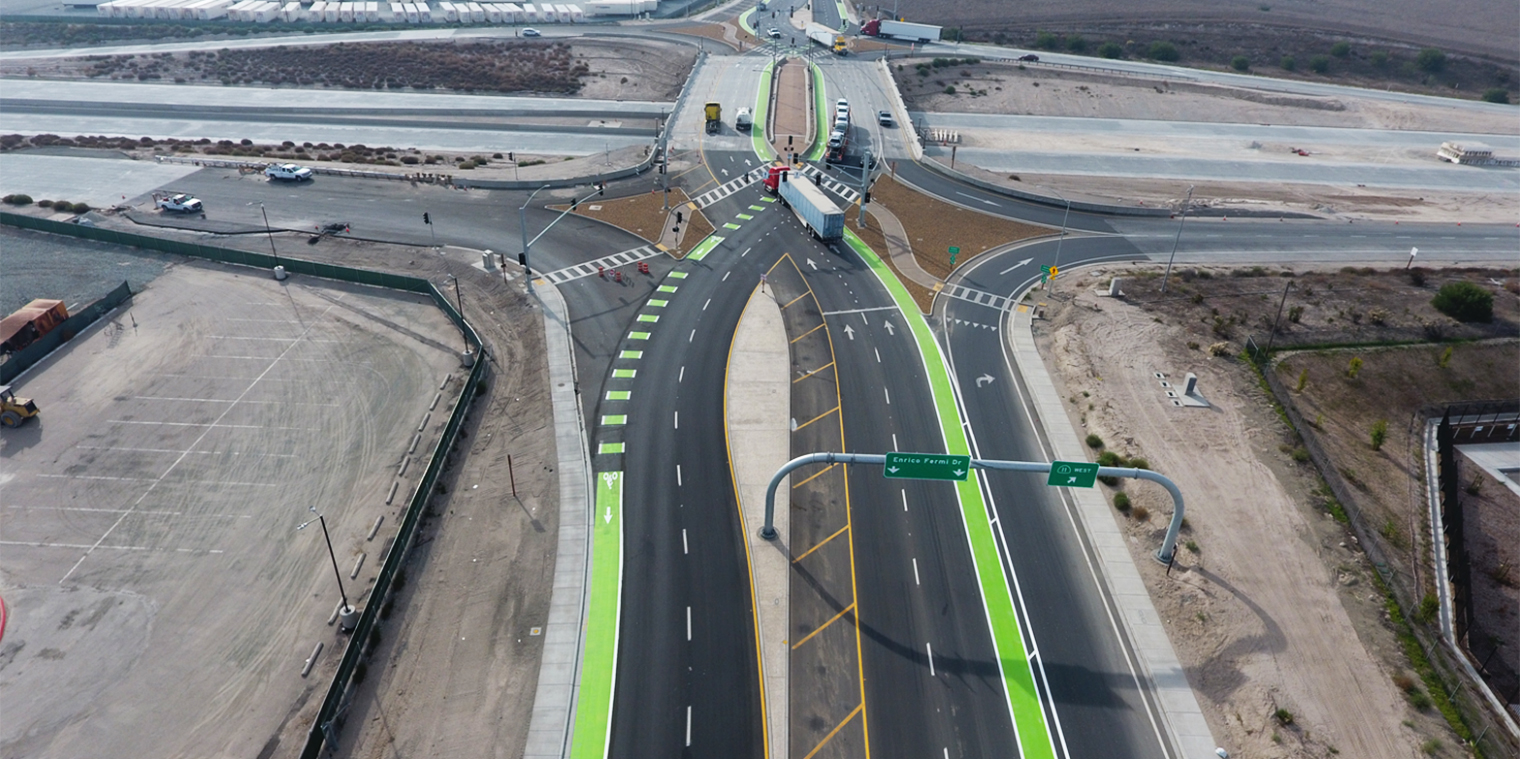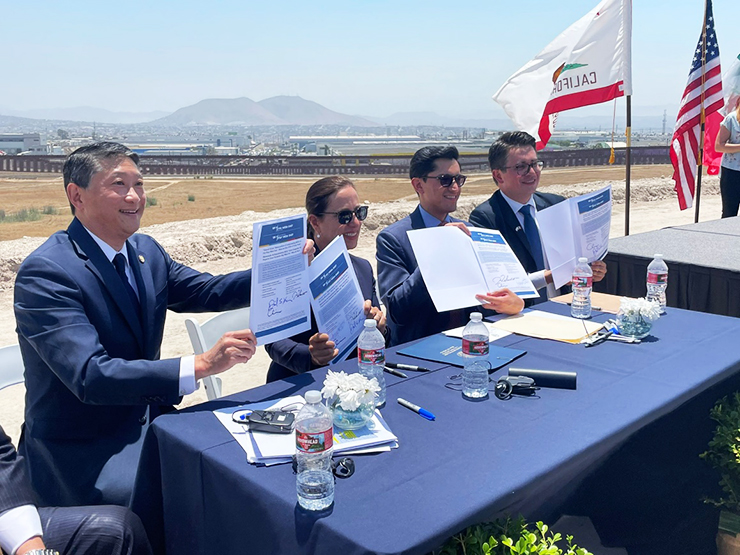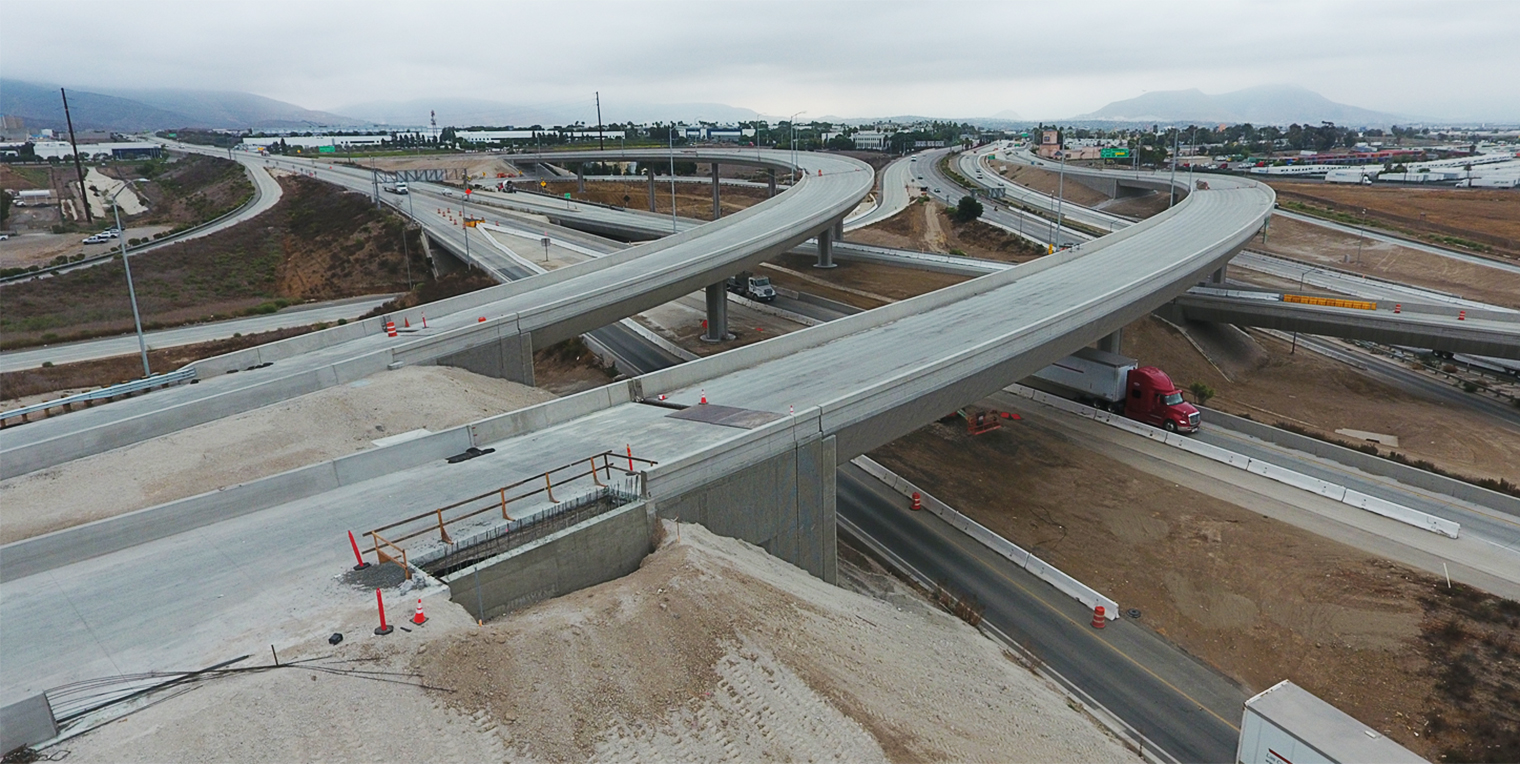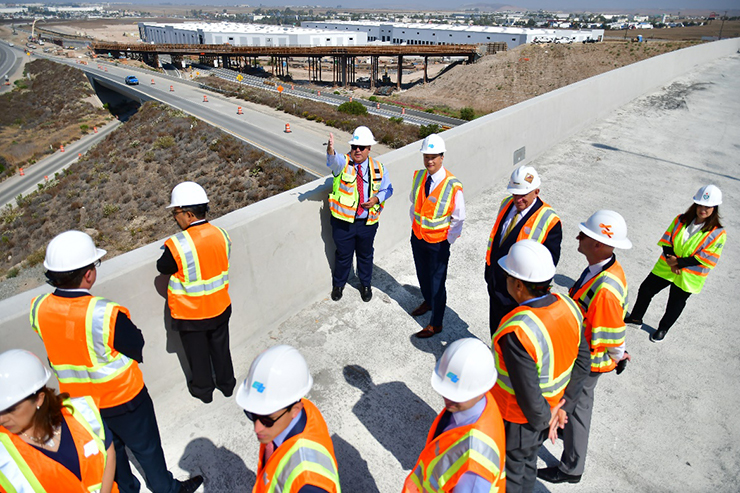Project Spotlight: Otay Mesa East Land Port of Entry

Caltrans a key player in creating new trade/travel corridor between U.S., Mexico

The finish line is in sight for a massive construction project to create a new land port of entry between the U.S. and Mexico, a 20-year-plus undertaking that Caltrans has been a key player in developing and building.
When complete, the State Route 11/Otay Mesa East Land Port of Entry project will open a new trade and travel corridor between the two nations that is expected to reduce border wait times, reduce greenhouse gas emissions, bolster economic growth, enhance regional mobility, strengthen border security and resiliency, and reinforce a binational and regional bond.
The new port of entry, with state-of-the-art multimodal features and companion facilities, is being delivered at a critical time in the history of this mega-region that links the two countries. Approximately 7.3 million people live on both sides of the 150-mile international border separating California and Baja California. One out of every 10 persons entering the U.S. crosses through one of the seven California land ports of entry located in Caltrans regional District 11, with about 154 million people crossing the California/Baja California corridors from both directions in 2019.
The San Ysidro port of entry is the busiest land port of entry in the Western Hemisphere, while Otay Mesa port of entry (only 13 miles away) is the second busiest commercial/cargo facility on the southern border.
An economic bridge unites nations, regions

At a 2021 ceremony at the future site of the Otay Mesa East Port of Entry, from left, then-CalSTA Secretary David Kim and California Lt. Governor Eleni Kounalakis signed a memorandum of understanding for various operations with Roberto Velasco, Mexico’s undersecretary for North American Affairs of the Ministry of Foreign Relations, and Rogelio Rivero, director general for Mexico’s Roadway Development for the Ministry of Communications and Transportation.
The proximity between cities on both sides of the border has resulted in an interdependent relationship, including shared economic, social, and environmental concerns, border infrastructure, and a linked transportation system. California’s biggest trading partner is Mexico, with more than $72 billion in goods exchanged in 2020, an amount that is expected to increase significantly in the coming years with the recent passage of the United States-Mexico-Canada Agreement.
Ninety percent of this trade occurred via truck, and about 72 percent of the total California trade with Mexico used the existing Otay Mesa point of entry.
However, the volume of goods, and visitors, that pass through the limited number of border entries has translated to lost time and productivity. Travelers crossing the border between Tijuana and San Diego in passenger vehicles historically experience wait times of up to two hours, with peak wait times sometimes exceeding five hours, and commercial vehicles wait one to two hours on average and for as long as more than four hours. The delays result in billions of dollars lost in economic output and tens of thousands of jobs lost in the U.S. and Mexico due to these border delays.
The pressures upon those two entry points led leaders on both sides of the border to begin taking action to add another trade/travel corridor in the 1990s.
Plans for Otay Mesa East take shape
In the mid-1990s, Caltrans leaders, in partnership with the San Diego Association of Governments (SANDAG), envisioned a new state-of-the-art Otay Mesa East point of entry to alleviate border chokepoints.
A 1998 signing of a Memorandum of Understanding by leaders from California and Baja California created the Otay Mesa-Mesa de Otay Binational Corridor, the first of many cross-border project milestones essential for the construction of the SR-11/Otay Mesa East Port of Entry (POE) Corridor Project.
The project development process formalized in 2006. Numerous other local, state, federal, and international accords were struck that have paved the way for the development of the new border crossing.
The project has undergone extensive environmental clearances to proceed, culminating in approval by the U.S. Secretary of State.
Caltrans also completed a complex acquisition process for more than 120 acres of right of way for the proposed port of entry site. The footprint for the associated facilities is larger than the current San Ysidro and existing Otay Mesa point of entries put together, and an approximate equivalent area for State Route 11.
Construction for the projects that lay the groundwork for the SR-11/Otay Mesa East POE Corridor Project began in October 2013, when work on the first segment of SR 11 began.

Transportation links mostly complete
Most of the transportation facilities are now nearing completion. Upcoming projects include site preparations, new utility services and utility relocations, bridging documents for the design and construction of the new port entry, and a California Highway Patrol commercial vehicle enforcement facility to be maintained by Caltrans. The anticipated completion date is September 2024.

Caltrans staff designed and constructed all roadway facilities associated with this point of entry, which pulled in 74 Caltrans employees, 29 consulting firms, and about 70 contractors’ personnel on any given day. These facilities include:
- The new State Route 11, which will provide direct access to the new port of entry.
- Three new freeway connections between SR 125, SR 905 and SR 11.
- A Border Wait Time Detection System, which will provide live information on wait status at other ports of entry in the region so travelers can make informed decisions on their routes.
- The new CHP enforcement facility, which should decrease wait times and improve secure border crossings for commercial vehicles.
- A new diverging diamond interchange, which should relieve truck traffic from the existing CHP enforcement facility and is the second of its kind in California.
These unique features of the SR-11/Otay Mesa East project are predicted to decrease peak wait times for border crossers by 50 percent upon opening of the port of entry, improve environmental sustainability by mitigating greenhouse gas emissions related to border delays, and generate approximately $1.8 billion in economic gains. It’s also estimated that the new port of entry, by helping unkink a major supply chain obstacle, will save more than 16,000 jobs by 2025, and will ultimately provide an overall cost/benefit ratio of 10-to-1.
Less waiting in line = Cleaner air
In addition to decreasing border wait times, the project’s integrated operations system also should cut down emissions from idling traffic. Today, border delays at California-Baja California land ports of entry produce an average of 457 metric tons of carbon dioxide emissions daily.
According to a recent analysis, carbon dioxide levels will drop by 22 percent between 2016 and 2035, supporting federal, state, and environmental justice goals and improving regional air quality.
The SR 11/Otay Mesa East project has received strong financial backing from the state of California. The project is funded through federal, state, and local sources.
About 40 percent of the secured project funding, totaling nearly $600 million, comes from Senate Bill 1’s Trade Corridor Enhancement Program, and the State Highway Operations and Protection Program (SHOPP). In October 2021, the California Transportation Commission allocated $24.9 million in federal Coordinated Border Infrastructure Funds toward construction of the project.
The Otay Mesa East POE will be the first national border crossing project to incorporate dynamic tolling based on congestion, which is intended to allow reliable and predictable border crossings with an average wait time goal of 20 minutes.
Otay Mesa East Port of Entry will reduce Emissions
A binational partnership
The project has been a prototype of binational coordination, with jointly developed studies on traffic and revenue, traffic approach management on both sides of the border, and dynamic tolling. An example of this cooperation came in June 2021 when the state of California, local partners, and the Mexican federal agencies signed a Memorandum of Understanding outlining major milestones and goals of the project, such as toll sharing, mirrored intelligent transportation systems, and opening date of late 2024 for both countries.
Caltrans District 11, along with SANDAG, has been responsible for the project inception and continuity, working with Mexican government as well as with federal agencies that include the U.S. Department of Homeland Security, U.S. Customs and Border Protection, Federal Highway Administration, the Federal Motor Carrier Safety Administration and General Services Administration, as well as coordinating with multiple state and local agencies.
Source: Caltrans Regional District 11.

